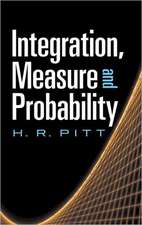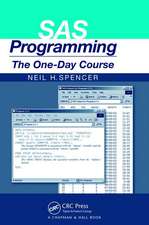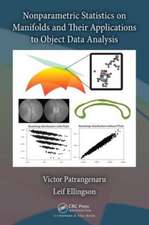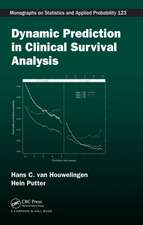Probabilistic Foundations of Statistical Network Analysis: Chapman & Hall/CRC Monographs on Statistics and Applied Probability
Autor Harry Craneen Limba Engleză Paperback – 19 apr 2018
The author’s incisive commentary supplements these core concepts, challenging the reader to push beyond the current limitations of this emerging discipline. With an approachable exposition and more than 50 open research problems and exercises with solutions, this book is ideal for advanced undergraduate and graduate students interested in modern network analysis, data science, machine learning, and statistics.
| Toate formatele și edițiile | Preț | Express |
|---|---|---|
| Paperback (1) | 432.50 lei 43-57 zile | |
| CRC Press – 19 apr 2018 | 432.50 lei 43-57 zile | |
| Hardback (1) | 919.10 lei 43-57 zile | |
| CRC Press – 20 apr 2018 | 919.10 lei 43-57 zile |
Din seria Chapman & Hall/CRC Monographs on Statistics and Applied Probability
- 9%
 Preț: 731.83 lei
Preț: 731.83 lei -
 Preț: 347.49 lei
Preț: 347.49 lei -
 Preț: 328.46 lei
Preț: 328.46 lei - 9%
 Preț: 1243.61 lei
Preț: 1243.61 lei - 9%
 Preț: 645.60 lei
Preț: 645.60 lei - 8%
 Preț: 396.90 lei
Preț: 396.90 lei -
 Preț: 373.59 lei
Preț: 373.59 lei - 8%
 Preț: 397.48 lei
Preț: 397.48 lei - 9%
 Preț: 1040.72 lei
Preț: 1040.72 lei - 9%
 Preț: 643.14 lei
Preț: 643.14 lei -
 Preț: 340.83 lei
Preț: 340.83 lei - 9%
 Preț: 645.45 lei
Preț: 645.45 lei - 9%
 Preț: 682.97 lei
Preț: 682.97 lei - 20%
 Preț: 690.21 lei
Preț: 690.21 lei - 18%
 Preț: 1111.90 lei
Preț: 1111.90 lei - 18%
 Preț: 1115.51 lei
Preț: 1115.51 lei - 9%
 Preț: 606.13 lei
Preț: 606.13 lei - 18%
 Preț: 1118.65 lei
Preț: 1118.65 lei - 18%
 Preț: 1118.99 lei
Preț: 1118.99 lei - 25%
 Preț: 526.38 lei
Preț: 526.38 lei - 25%
 Preț: 427.84 lei
Preț: 427.84 lei -
 Preț: 486.70 lei
Preț: 486.70 lei - 25%
 Preț: 499.81 lei
Preț: 499.81 lei - 15%
 Preț: 674.37 lei
Preț: 674.37 lei - 25%
 Preț: 487.34 lei
Preț: 487.34 lei - 26%
 Preț: 876.78 lei
Preț: 876.78 lei - 18%
 Preț: 703.79 lei
Preț: 703.79 lei - 27%
 Preț: 996.14 lei
Preț: 996.14 lei - 22%
 Preț: 413.08 lei
Preț: 413.08 lei - 25%
 Preț: 456.19 lei
Preț: 456.19 lei - 15%
 Preț: 489.26 lei
Preț: 489.26 lei - 18%
 Preț: 760.35 lei
Preț: 760.35 lei - 15%
 Preț: 718.62 lei
Preț: 718.62 lei - 26%
 Preț: 877.30 lei
Preț: 877.30 lei - 18%
 Preț: 919.10 lei
Preț: 919.10 lei - 28%
 Preț: 631.16 lei
Preț: 631.16 lei - 27%
 Preț: 1000.51 lei
Preț: 1000.51 lei - 29%
 Preț: 627.88 lei
Preț: 627.88 lei - 18%
 Preț: 1280.44 lei
Preț: 1280.44 lei - 23%
 Preț: 376.17 lei
Preț: 376.17 lei - 18%
 Preț: 1156.73 lei
Preț: 1156.73 lei - 18%
 Preț: 1326.99 lei
Preț: 1326.99 lei - 15%
 Preț: 671.64 lei
Preț: 671.64 lei - 15%
 Preț: 676.33 lei
Preț: 676.33 lei - 15%
 Preț: 489.26 lei
Preț: 489.26 lei
Preț: 432.50 lei
Nou
Puncte Express: 649
Preț estimativ în valută:
82.76€ • 86.64$ • 68.48£
82.76€ • 86.64$ • 68.48£
Carte tipărită la comandă
Livrare economică 07-21 aprilie
Preluare comenzi: 021 569.72.76
Specificații
ISBN-13: 9781138630154
ISBN-10: 1138630152
Pagini: 256
Dimensiuni: 156 x 234 x 12 mm
Greutate: 0.37 kg
Ediția:1
Editura: CRC Press
Colecția Chapman and Hall/CRC
Seria Chapman & Hall/CRC Monographs on Statistics and Applied Probability
Locul publicării:Boca Raton, United States
ISBN-10: 1138630152
Pagini: 256
Dimensiuni: 156 x 234 x 12 mm
Greutate: 0.37 kg
Ediția:1
Editura: CRC Press
Colecția Chapman and Hall/CRC
Seria Chapman & Hall/CRC Monographs on Statistics and Applied Probability
Locul publicării:Boca Raton, United States
Cuprins
Introductory remarks. Modeling principles. Modeling network structure. Model properties and their signi cance in statistical inference. Framework for modeling.
Notă biografică
Harry Crane is Associate Professor and Co-Director of the Graduate Program in Statistics and Biostatistics and an Associate Member of the Graduate Faculty in Philosophy at Rutgers University. Professor Crane’s research interests cover a range of mathematical and applied topics in network science, probability theory, statistical inference, and mathematical logic. In addition to his technical work on edge and relational exchangeability, relative exchangeability, and graph-valued Markov processes, Prof. Crane’s methods have been applied to domain-specific cybersecurity and counterterrorism problems at the Foreign Policy Research Institute and RAND’s Project AIR FORCE.
Recenzii
"I believe this book can serve both as a reference and textbook, but primarily should be seen as a textbook for a course built around foundational aspects of statistical modeling for network data. Most prior texts I am aware of focus on statistical methods within existing network models. I really like that this book helps the reader understand the statistical implications of choice of model, both in terms of "coherence" and sampling. Most prior work presents the field of statistical network analysis as a basket of models from which one chooses their preferred method. Crane takes a more foundational approach - showing how choice of model leads to implicit statistical assumptions that too often go unspoken."
~Walter Dempsey, Harvard University
"A set of useful exercises are given in almost all chapters that assists in understanding the topics and – what is very useful and much appreciated – the author also gives their solutions. These are not only a great tool because they allow solutions to be checked, but because somehow they are a complement of the text. Moreover, they provide the opportunity to dive thoroughly into the topics. Finally, the author not only proposes these exercises in each chapter, he also proposes problems that are open research questions. These are very nice inputs for researchers who are working in the field. And in this way, the author opens a door to further research and establishes a dialog between him and the reader."
~Silvano Romano, ISCB Newsletter
~Walter Dempsey, Harvard University
"A set of useful exercises are given in almost all chapters that assists in understanding the topics and – what is very useful and much appreciated – the author also gives their solutions. These are not only a great tool because they allow solutions to be checked, but because somehow they are a complement of the text. Moreover, they provide the opportunity to dive thoroughly into the topics. Finally, the author not only proposes these exercises in each chapter, he also proposes problems that are open research questions. These are very nice inputs for researchers who are working in the field. And in this way, the author opens a door to further research and establishes a dialog between him and the reader."
~Silvano Romano, ISCB Newsletter
Descriere
The book discusses fundamental considerations for modeling network data of various kinds. The book's major novelty is the emphasis on understanding and building models from first principles, rather than choosing from a list of models that are already available. A main goal of the book is to explain the logic and rationale behind the technical aspects of recent work on network modeling and to discuss how those considerations compare to alternative approaches.











